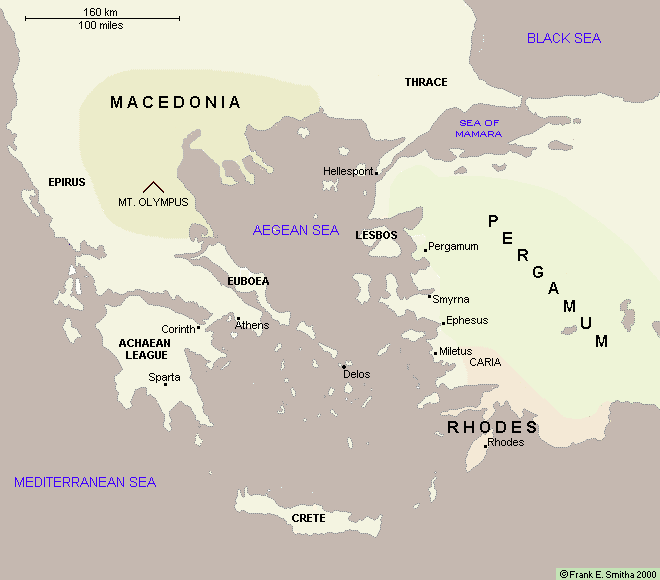
Pergamum
Ancient Greek city in Mysia, situated 16 miles from the Aegean Sea on a lofty isolated hill on the northern side of the broad valley of the Caicus (modern Bakir) River. The site is occupied by the modern town of Bergama, in the il (province) of Izmir, Turkey. Pergamum existed at least from the 5th century BC, but it became important only in the Hellenistic Age (323-330 BC), when it served as the residence of the Attalid dynasty. Their fortress and palace stood on the peak of the hill, while the town itself occupied the lower slopes. Under the Roman Empire the city was situated on the plain below.
It had formal autonomy under the Attalids, who, however, interfered in most aspects of civic government. Initially they ruled Pergamum as vassals of the Seleucid Kingdom, but Eumenes I declared himself independent of Antiochus I (263 BC); when he died in 241 he was succeeded by his nephew Attalus I, who defeated the Galatians and assumed the royal title; the dynasty received its name from him. The original Attalid territory around Pergamum (Mysia) was greatly expanded by 188 BC with the addition of Lydia (excluding most Greek coastal cities), part of Phrygia, Lycaonia, and Pisidia (from 183 BC), all former Seleucid territories. This expansion was accomplished as the result of Eumenes II's alliance with Rome in its conflict with the Seleucid Antiochus III.
When Eumenes' son and second successor, Attalus III, died without an heir, he bequeathed the kingdom to Rome (133). Rome accepted it and set up the province of Asia (129), which included Ionia and the territory of Pergamum, but left the other regions to neighbouring kings, who were clients of Rome. The kingdom of Pergamum yielded much wealth, especially in agricultural surpluses and silver, first to the Attalid rulers and later to Rome.
The Attalids made the city of Pergamum one of the most important and beautiful of all Greek cities in the Hellenistic Age; it is one of the most outstanding examples of city planning in that period. They built a library excelled only by that at Alexandria. The kings after Attalus I collected many works of art from Greece to adorn the city's temples and courtyards, supplementing the many works of sculpture, painting, and decoration commissioned from resident artists. In Roman times its population was an estimated 200,000. Excavations that were begun in 1878 under the auspices of the Berlin Museum, besides unearthing many artistic treasures, have enabled archaeologists to reconstruct the plan of the most important areas of the Hellenistic city. Its monuments included a theatre; the temple to Athena Nicephorus; and the great altar of Zeus with its richly decorated frieze, a masterpiece of Hellenistic art. A part of the altar and its surviving reliefs, restored and mounted, now stands in the Pergamon Museum in Berlin.
The civic structures of the lower city included a large marketplace, a gymnasium, and temples of Hera and Demeter. Roman remains include an amphitheatre, a theatre, and a racetrack. The early Attalids erected the first structures of the upper (royal) city, but the later kings Eumenes II and Attalus III, by their extensive building and rebuilding, were chiefly responsible for the city's great architectural and artistic reputation. After the fall of Rome, Pergamum was ruled by the Byzantines until it passed into Ottoman hands early in the 14th century. (Encyclopedia Britannica)